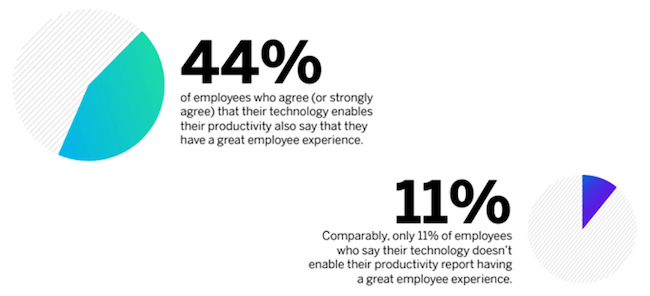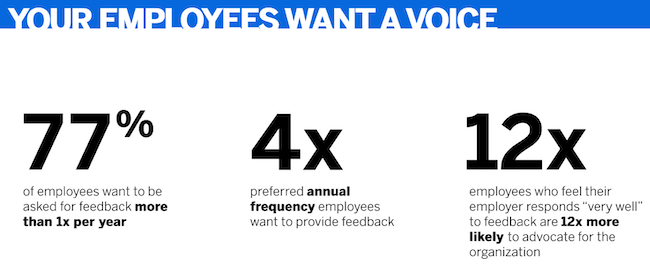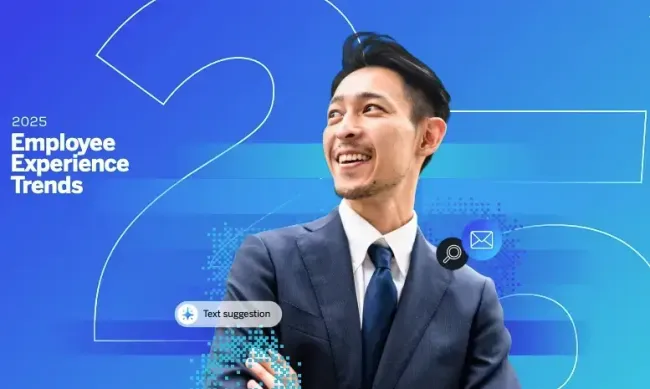While working from home (WFH), and increasingly, working from anywhere (WFA) was gaining traction with many businesses pre-2020, it took COVID-19 to make it a necessity. The technology talent in IT departments around the world were some of the unsung superheroes of the pandemic, tirelessly getting and keeping their remote teams online and functioning.
And two legacies of the pandemic appear to be the rapid adoption of:
- hybrid working: employees will work some days in the office and some at home; and
- hybrid work from home: where some team members are office-based and others home-based.
With this approach, what is certain is that workplace technology must continue to support every employee, wherever they’re working, and this technology must enable them to be productive and engaged, and to feel included and safe. In short, to have a great employee experience.
And when a company offers an all-around great employee experience, which includes the technology experience, people will want to stay and make a career, and top talent will come knocking on the door to work there. Conversely, a poor experience will drive many good people to leave for somewhere with a more tech-enabled and savvy IT strategy.
We’ll look at three technology challenges in the 21st-century workplace and how actively listening to your employees can help you overcome them.
Get the playbook top HR teams are using to design a world-class tech employee experience
Tech challenge 1 – creating the best technology experience
Productivity and collaboration are two essential factors for business success. It’s a fact that the technology experiences your employees have can make or break that collaboration and productivity. Research shows a strong correlation between an employee’s digital workplace experience and engagement, intent to stay, and likelihood to recommend their company as a good place to work. Employees whose technology experience exceeds their expectations are more than three and a half times more likely to say their employee experience as a whole exceeds their expectations:

Fit-for-purpose technology helps employees feel more engaged with their work, feel that their workplace is an enjoyable place to be, and recommend their organization to others.
How to create the best possible workplace technology experiences
The future world of work will depend upon people feeling connected, productive, that they’re doing something worthwhile and that they belong. To create a better employee digital experience, you’ll need to:
Make your workspace experiences all about your people
The time has gone when tech is simply a blunt instrument to save the organization time and money. The focus is now on saving individual employees time, and enabling their efficiency, as well as helping them collaborate and participate.
Fit work to employees’ lifestyles
The pandemic proved to previously doubting leaders that employees can be just effective working from home as in the office – maybe even more so. Yes, people took time out of their 9 to 5 to exercise, home school their children, or take mental health breaks, but they still got the work done. The digital workplace of the future will need to be personalized to individual employees and their preferred ways of working, with new technology available to enable this.
Implement technology training for all
This is paramount. Research shows that older people in the workforce are more negative about and resistant to, using new technologies. Collaboration platforms such as Zoom, Teams, and Slack, which were such lifelines during the pandemic were not necessarily embraced by all. Thus, it will be necessary to provide everyone in your organization with tech training that is supportive, thorough, and compelling.
Tech challenge 2 – hybrid working is here to stay
Despite the stresses of a global pandemic and resultant remote working, employees say that mentally, physically, and financially, they are better off for being out of the 9-to-5-commute-to-work ‘rat race’. Our research found:
- Half of employees (50%) indicate that their mental health and well-being have improved; only 19% say it has worsened.
- Half of employees (50%) indicate that their physical health and well-being have improved; only 18% say it has worsened.
- Nearly half of employees (43%) indicate that their financial health well-being improved; just 12% say it has worsened.
Few employees have the appetite to return to full-time office work. The same research revealed that employees prefer spending two days per week in the office, with the flexibility to choose where and when they work outside of those days.
For companies to be successful, they’ll need to embrace the digital transformation by providing a combination of workplace locations. And of course, this will mean putting in place the best, most effective technology and digital tools to support hybrid working. And this will include ensuring that both in-house and remote workers get an equal voice and access to resources.
How to support hybrid working with technology experiences
Now is the time to get your HR and your IT departments working together to deliver an inclusive hybrid workplace experience that works for every employee – wherever they are.
Give everyone an excellent tech experience
One of the major WFH challenges that the pandemic threw up was a gap in workplace equity. Not all remote workers had reliable broadband, laptops, desktops, even comfortable chairs, which made the tech experience unequal across the workforce. You need to listen to what each individual employee needs to facilitate their hybrid working and close the gaps between their in-house and remote work tech experiences, so everyone’s on a level playing field.
Listen continuously, act immediately
Hybrid workers can’t just shout across the office to co-workers that their screen has frozen, or they’re locked out of their email. You need to have robust feedback mechanisms in place so your hybrid workers can report issues as soon as they happen (and before they escalate into problems). And have in place equally robust action plans to address them. Hybrid working adds a level of complexity to the employee experience, and listening is the way to manage it.

Embrace agility
We’ve all had to change mindsets, behaviors, and working practices in response to the pandemic, and by and large, things worked out. Leaders need to continue being open to agile ways of working, remote work, and embracing change at short notice – expecting the unexpected. By setting up a two-way dialogue with employees, you’ll be able to develop and improve your hybrid workplace experience until it becomes the new normal.
Tech challenge 3 – making home offices as good as company offices
When 50% of employees report that their physical and mental health and well-being have improved by working from home, you want to keep your people on that wellness track. And it turns out that having a proper, dedicated home office (as opposed to the kitchen table or the space under the stairs) impacts remote employee satisfaction significantly:
- 83% of employees with a home office agree or strongly agree that they have the resources that they need to do their job properly (materials, equipment, technology, etc).
- 67% of employees without a home office, agree or strongly agree that they have access to the necessary resources.
- 79% of employees with a home office say that their company’s technology helps them be as productive as possible, BUT…
- Only 55% of employees without a home office say that their company’s technology helps them be as productive they can.
You get the picture.
How to close the home office technology experience gap
Workplace equity needs to be part of your diversity, equity and inclusion (DEI), and belonging programs. By closing the gap between employees who have a dedicated home office space and those who don’t, you are creating an equitable workplace for all. Get started by:
Asking what each employee needs
Some employees may need only a laptop, phone, and broadband in their home. Others may need a desk and chair, a wireless booster for poor signal, and a laptop upgrade because their old machine does not have a camera. Employees who work in an uncomfortable space or have to use inferior tech or connectivity are more at risk of suffering from workplace stress or burnout, so it pays to level the playing field.
Supplying or paying for a home office setup
We’re not suggesting an office cabin in the garden here, just resources to create a comfortable, fully functional office space. Fast, reliable broadband and powerful wireless routers go a long way to making employees’ tech functionality less stressful and don’t forget some office swag to make everyone feel part of the team.
Negotiating preferential rates with tech suppliers
Make life easier for employees by giving them special rates with certain retailers so they can spend their tech budget how they like. People’s well-being and productivity get boosted when they have all the right, working resources in their remote space as well as in-house.
Free eBook: The HR leader's success kit to enabling a remote workforce
Tech challenge 4 – security risks of hybrid working
Working from home rather than at an office brings with it cybersecurity issues that need addressing, especially when hybrid working is likely to become the norm. One report found that 67% of remote data breaches were credential thefts, compromised business emails, and phishing attacks, and 27% of attacks were caused by ignorance and human error. So, what can companies do to protect their remote workers’ cyber-security?
Enable individual employees
The individual is the first line of defense. In a remote world, it’s harder to keep an eye on behaviors, so it’s important to educate employees about cybersecurity, and offer immediate support when they’re not sure how to do something or flag concerns.
Invest in the right technology
In an office environment, security controls can be kept ‘within the castle walls’. But remote workers may be accessing cloud accounts or company servers over public networks with their home routers that may have exposed modem control interfaces. Public WiFi may also lead to compromises. By using the latest security software on company servers, IT professionals can monitor for security breaches and isolate a device infected with malware.
Use a VPN
A VPN allows the flow of information to be encrypted between remote devices and the VPN server. It needs to be properly configured and its software regularly updated to stay secure.
Backup, backup, backup
Breaches do happen, and it’s vital that you’re able to recover your data. Put in place a back-up disaster recovery IT strategy so you can retrieve your data from another facility if one or more gets compromised.
Using Qualtrics to solve your workplace tech challenges
As we’ve said, the best way to address the biggest challenges with workplace technology is to listen to your employees, then act on what they say. Using employee feedback surveys, you’ll be able to pinpoint exactly what your people need to remain engaged, productive, and secure. Survey data will pinpoint the gaps in the digital workplace employee experience so you can make targeted investments in your hybrid workforce and their resources.
Get the playbook top HR teams are using to design a world-class tech employee experience



